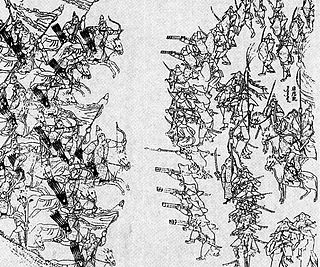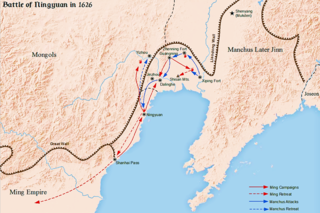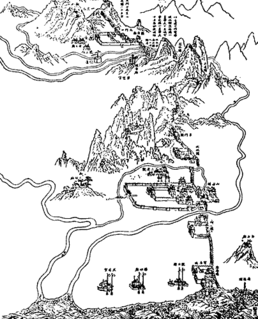
The Battle of Sarhū refers to a series of battles between the Later Jin dynasty and the Ming dynasty and their Joseon allies in the winter of 1619. The battle is notable for the heavy use of cavalry by the Later Jin in defeating Ming and Joseon forces equipped with hand cannons, cannons, and matchlocks.

The Later Jin invasion of Joseon occurred in early 1627 when the Later Jin prince Amin lead an invasion of Korea's Joseon kingdom. The war ended after three months with the Later Jin establishing itself as sovereign tributary overlord over Joseon. However Joseon continued its relationship with the Ming dynasty and showed defiance in solidifying its tributary relationship with the Jurchens. It was followed by the Qing invasion of Joseon in 1636.

The Battle of Shanhai Pass, fought on May 27, 1644 at Shanhai Pass at the eastern end of the Great Wall of China, was a decisive battle leading to the formation of the Qing dynasty in China. There, Qing Prince-Regent Dorgon allied with former Ming general Wu Sangui to defeat rebel leader Li Zicheng of the Shun dynasty, allowing Dorgon and the Manchus to rapidly conquer Beijing and replace the Ming dynasty.

The Battle of Ningyuan was a battle between the Ming dynasty and the Jurchen Later Jin in 1626. The Jurchen Later Jin had been waging war on the Ming for several years, and their leader Nurhaci had deemed Ningyuan to be a suitable target for his attack, in part due to advice from a Chinese defector, Li Yongfang. Later Jin failed to take the city and Nurhaci was wounded in the assault, dying eight months later. The Ming emerged victorious, marking a temporary resurgence of the Ming army after an eight-year-long series of defeats.
Zu Dashou, courtesy name Fuyu, was a Chinese military general who served on the northern border of the Ming dynasty during the Manchu conquest of China. He fought against the Manchu-led Qing dynasty in several major engagements before ultimately surrendering to them in 1642. An alleged descendant of the Eastern Jin dynasty general Zu Ti (祖逖), he was the maternal uncle of the Ming general Wu Sangui, who surrendered Shanhai Pass to Qing forces and defected to the Qing side. Zu's tomb was acquired by the Royal Ontario Museum in Toronto, Canada, and is considered one of the "iconic objects" of the museum.

The transition from Ming to Qing or the Ming–Qing transition, also known as the Manchu conquest of China, was a decades-long period of conflict between the Qing dynasty, established by Manchu clan Aisin Gioro in contemporary Northeast China, the Ming dynasty, and various other rebel powers in China, such as the short-lived Shun dynasty led by Li Zicheng. Leading up to the Qing conquest, in 1618, Aisin Gioro leader Nurhaci commissioned a document entitled the Seven Grievances, which enumerated grievances against the Ming and began to rebel against their domination. Many of the grievances dealt with conflicts against the Ming-backed Yehe clan of the Jurchens. Nurhaci's demand that the Ming pay tribute to him to redress the seven grievances was effectively a declaration of war, as the Ming were not willing to pay money to a former tributary. Shortly afterwards, Nurhaci began to rebel against the Ming in Liaoning.

The Ming Great Wall, built by the Ming dynasty (1368–1644), forms the most visible parts of the Great Wall of China today. A comprehensive archaeological survey, using advanced technologies, has concluded that the Ming walls measure 8,850 km (5,500 mi) from Jiayu Pass in the west to the sea in Shanhai Pass, then looping over to terminate in Manchuria at the Hushan Great Wall. This is made up of 6,259 km (3,889 mi) sections of actual wall, 359 km (223 mi) of trenches and 2,232 km (1,387 mi) of natural defensive barriers such as hills and rivers.
The Battle of Dalinghe (大凌河之役) was a battle between the Jurchen Later Jin and the Ming dynasty that took place between September and November 1631. The Manchus besieged and captured the fortified northern Ming city of Dalinghe in Liaoning. Using a combined force of Manchu and Mongol cavalry, along with recently captured Chinese artillery units, Manchu leader Hong Taiji surrounded Dalinghe and defeated a series of Ming reinforcement forces in the field. The Ming defenders under general Zu Dashou surrendered the city after taking heavy losses and running out of food. Several of the Ming officers captured in the battle would go on to play important roles in the ongoing Manchu conquest of China. The battle was the first major test for the Chinese firearms specialists incorporated into the Manchu military. Whereas the Manchus had previously relied primarily on their own Eight Banners cavalry in military campaigns, after the siege of Dalinghe the Chinese infantry would play a larger role in the fighting. Unlike Nurhaci's failed siege at the Battle of Ningyuan several years prior, the siege of Dalinghe was a success that would soon be replicated in Songshan and Jinzhou, paving the way for the establishment of the Qing dynasty and the ultimate defeat of the Ming.

The Battle of Fushun was the first military conflict in the war between the Jurchen-led Later Jin and the Ming dynasty. The battle ended in a decisive victory for the Later Jin and resulted in the capture of Fushun and two other nearby fortresses.
The Battle of Qinghe was a military conflict between the Jurchen Later Jin and Ming dynasty in the summer of 1618. The battle ended with the Jin conquest of Qinghe despite taking heavy casualties.
The Battle of Tieling was a military conflict between the Later Jin and Ming dynasty. In the summer of 1619 Nurhaci invaded the town of Tieling, the ancestral home of the Li clan. Ming had fortified the town with cannons, but many of their soldiers defected to the Jin, and they were unable to reload their cannons before the walls were taken. Li Ruzhen, one of the last scions of the Tieling Li, fled the battle.

The Battle of Xicheng was a military conflict between the Yehe Jurchens, their Ming allies, and the Later Jin. In the fall of 1619 Nurhaci invaded Xicheng, the home of the Yehe Jurchens. Nurhaci personally led the vanguard and took the east wall. After capturing the city the Yehe inhabitants were spared, but their Ming allies who had fought beside them were executed.

The Battle of Shen-Liao was a military conflict between the Later Jin and the Ming dynasty. In early 1621 Nurhaci, khan of the Later Jin, invaded Liaodong and captured the cities of Shenyang and Liaoyang from the Ming.

The Battle of Fort Zhenjiang was a military conflict between the Later Jin and the Ming dynasty. In the fall of 1621 Ming general Mao Wenlong captured Fort Zhenjiang on the border of the Jin-Joseon border and held it against multiple Jin assaults before retreating. Nurhaci burnt down the fort afterwards rather than risk having it captured again.

The Battle of Guanging was a military conflict between the Manchu forces of the Later Jin and the Ming dynasty of China. It occurred at and around the Ming's northern city of Guangning, which fell to the Later Jin in 1622.

The Battle of Ning-Jin was a military conflict between the Later Jin and Ming dynasty. In the spring of 1627 the Jin khan Hong Taiji invaded Ming territory in Liaoning under the pretext of illegal construction on Jin lands.
The Jisi Incident (己巳之變) was a military conflict between the Later Jin and Ming dynasty, named because it happened in 1629, a jisi year according to the Chinese sexagenary cycle. In the winter of 1629 Hong Taiji bypassed Ming's northeastern defenses by breaching the Great Wall of China west of the Shanhai Pass and reached the outskirts of Beijing before being repelled by reinforcements from Shanhai Pass. The Later Jin secured large amounts of war material by looting the region around Beijing. This was the first time the Jurchens had broken through the Great Wall into China proper since they rose up against Ming China.
The Ordos campaign of 1592, also called the Ningxia campaign or Pubei rebellion, was a rebellion against the Ming dynasty by Liu Dongyang and Pubei, a Chahar Mongol who had previously submitted to the Ming, and its suppression.
Li Yongfang was a general of the Ming dynasty and Qing dynasty best known for being the first general defecting to the Qing dynasty, due to the Ming dynasty losing the city of Fushun in Liaoning to the Qing.

The Chahar-Jurchen War was a military conflict waged between the Chahar Mongols and the Jurchen Later Jin dynasty and several other Mongol groups from 1619 to 1634.
















